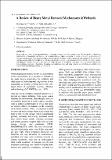| dc.description.abstract | Heavy metals are released into the environment from a wide range of natural and anthropogenic sources. The rate of influx of these heavy metals into the environment exceeds their removal by natural processes. Aquatic ecosystems are usually at the receiving end, usually with wetlands as intermediaries. Conventional clean up technologies arc either inadequate or too expensive for some countries. In the past decades, therefore, research efforts has been directed to wetlands as an alternative low cost means of removing heavy metals from domestic, commercial. mining and industrial discharge of wastewaters. This paper discusses the potential for heavy metal removal by wetlands through reactions involving sedimentation. flocculation, absorption, co-precipitation, cation and anion exchange, complexation, precipitation, oxidation/reduction,
microbiological activity and plant uptake. | en_US |

